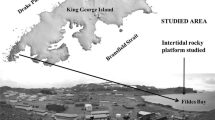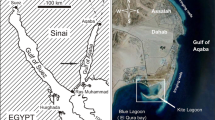Abstract
The purpose of this study was to further clarify marine tardigrade ecology; in particular, the monthly density fluctuations of Echiniscoides sigismundi and Styraconyx haploceros inhabiting the barnacle Fistulobalanus albicostatus in the intertidal zone. Both species were observed in all months, and the monthly body length distributions did not show a clear pattern, indicating these species breed throughout the year. However, the density of both species was higher in fall/winter than in spring/summer. The two species showed different prevalence and density distributions in the upper and lower parts of a barnacle bedrock in the intertidal zone. S. haploceros was found only in the lower part, where it dominated over E. sigismundi in most months. E. sigismundi was found in both parts, but its occurrence rate and density were higher in the lower part of the intertidal zone. The density of both species was significantly higher on the external surface of the barnacles than internally. No significant differences in tardigrade density were detected among different sizes of barnacles, living or dead, except for a significant difference in the density of E. sigismundi between dead and large live barnacles. Our findings suggest that E. sigismundi and S. haploceros are well adapted to inhabiting intertidal barnacles, and the fall/winter season is more favorable than spring/summer for marine tardigrades in temperate regions. E. sigismundi appears to tolerate the upper part of the barnacle bedrock in the intertidal zone, which may be an extremely harsh environment, better than S. haploceros.









Similar content being viewed by others
References
Bartels PJ, Fontaneto D, Roszkowska M, Nelson DR, Kaczmarek L (2020) Latitudinal gradients in body size in marine tardigrades. Zool J Linn Soc 188:820–838
Bertolani R (2001) Evolution of the reproductive mechanisms in tardigrades—a review. Zool Anz 240:247–252
Clausen LKB, Andersen KN, Hygum TL, Jørgensen A, Møbjerg N (2014) First record of cysts in the tidal tardigrade Echiniscoides sigismundi. Helgol Mar Res 68:531–537. https://doi.org/10.1007/s10152-014-0409-0
Crisp DJ, Hobart J (1954) A note on the habitat of the marine tardigrade Echiniscoides sigismundi (Schultze). Ann Mag Nat Hist 7:554–560
Crowe JH (1975) The physiology of cryptobiosis in tardigrades. Mem Ist Idrobiol 32:37–59
Crowe JH, Madin KA (1974) Anhydrobiosis in tardigrades and nematodes. Trans Am Microsc Soc 93:513–524. https://doi.org/10.2307/3225155
De Zio S, Grimaldi P (1966) Ecological aspects of Tardigrada distribution in South Adriatic beaches. Veröff Inst Meeresforsch Bremerh 2:87–94
Devasurmutt YR, Arpitha BM (2016) An introduction to phylum Tardigrada—review. IJLTEMAS 5:48–52
Guidetti R, Altiero T, Rebecchi L (2011) On dormancy strategies in tardigrades. J Insect Physiol 57:567–576
Hong SY (2006) Marine invertebrates in Korean coasts. Academy Publishing Company Incorporated, Seoul, p 479
Hygum TL, Clausen LKB, Halberg KA, Jørgensen A, Møbjerg N (2016) Tun formation is not a prerequisite for desiccation tolerance in the marine tidal tardigrade Echiscoides sigismundi. Zool J Linn Soc 178:907–911
Jørgensen A, Møbjerg N (2015) Notes on the cryptobiotic capability of the marine arthrotardigrades Styraconyx haploceros (Halechiniscidae) and Batillipes pennaki (Batillipedidae) from the tidal zone in Roscoff, France. Mar Biol Res 11:214–217. https://doi.org/10.1080/17451000.2014.904883
Kaczmarek L, Bartels PJ, Roszkowska M, Nelson DR (2015) The zoogeography of marine Tardigrada. Zootaxa 4037:1–189. https://doi.org/10.11646/zootaxa.4037.1.1
KHOA (2019) Annual report of Korea oceanographic observation network. Korea Hydrographic and Oceanographic Agency. http://www.khoa.go.kr/webzine/viewer.do?pub_seq=2017007&pub_type=3&sc_type=popup. Accessed 4 Mar 2021
KMA (2021) Weather Information (2016–2017). Korea Meteorological Administration. https://www.weather.go.kr/. Accessed 4 Mar 2021
Kristensen RM, Hallas TE (1980) The tidal genus Echiniscoides and its variability, with erection of Echinscoididae fam. n. (Tardigrada). Zool Scr 9:113–127
Kristensen RM, Higgins RP (1984) Revision of Styraconyx (Tardigrada: Halechinischidae), with descriptions of two new species from Disko Bay, West Greenland. Smithson Contrib Zool 391:40. https://doi.org/10.5479/si.00810282.391
Marcus E (1929) Tardigrada. Pp. 1–608 in: Bronn HG (ed) Klassen und Ordnungen des Tierreichs. vol 5. Akad Verlagsges, Leipzig, pp 1–608
Martinez EA (1975) Marine meiofauna of a New York City Beach, with particular reference to Tardigrada. Estuar Coast Mar Sci 3:337–348
Møbjerg N, Jørgensen A, Eibye-Jacobsen J, Halberg KA, Persson D, Kristensen RM (2007) New records on cyclomorphosis in the marine eutardigrade Halobiotus crispae (Eutardigrada: Hypsibiidae). J Limnol 66:132–140. https://doi.org/10.4081/jlimnol.2007.s1.132
Møbjerg N, Halberg KA, Jørgensen A, Persson D, Bjørn M, Ramløv H, Kristensen RM (2011) Survival in extreme environments—on the current knowledge of adaptations in tardigrades. Acta Physiol 202:409–420. https://doi.org/10.1111/j.1748-1716.2011.02252.x
Morgan CI (1977) Population dynamics of two species of Tardigrada, Macrobiotus hufelandii (Schultze) and Echiniscus (Echiniscus) testudo (Doyere), in roof moss from Swansea. J Anim Ecol 46:263–279
Morgan CI (1980) Notes on the distribution and abundance of the Irish marine Tardigrada, including two additions to the Irish fauna. Ir Nat J 20:129–172
Na JE, Lee HY (2011) Distribution of benthic algae in tidal flats of Saemangeum Lake, Korea. Korean J Environ Biol 29:46–51
Nelson DR (2002) Current status of the Tardigrada: evolution and ecology. Integr Comp Biol 42:652–659. https://doi.org/10.1093/icb/42.3.652
Nelson DR, Marley N (2000) The biology and ecology of lotic Tardigrada. Freshw Biol 44:93–108. https://doi.org/10.1046/j.1365-2427.2000.00586.x
Nelson DR, Guidetti R, Rebecchi L (2015) Phylum Tardigrada. In: Thorp J, Rogers DC (eds) Ecology and general biology: Thorp and Covich’s freshwater invertebrates. Academic Press, Cambridge, pp 347–380. https://doi.org/10.1016/B978-0-12-385026-3.00017-6
Pollock LW (1970) Distribution and dynamics of interstitial Tardigrada at Woods Hole, Massachusetts, USA. Ophelia 7:145–166
Pollock LW (1975) Observations on marine Heterotardigrada, including a new genus from the western Atlantic Ocean. Cah Biol Mar 16:121–132
Ramazzotti G, Maucci W (1983) II phylum Tardigrada (III edizione riveduta e aggiornata). Mem Ist Ital Idrobiol 41:1–1012
Rebecchi L, Guidi A, Bertolani R (2000) Tardigrada. In: Jamiesson BGM (ed) Reproductive biology of invertebrates. Progress in male gamete ultrastructure and phylogeny, Part B, vol IX. Oxford and IBH Publishing Co, New Delhi, pp 267–291
Renaud-Debyser J (1956) Repartition de deux Tardigrades Batillipes mirus Richters et Stygarctus bradypus Schultz dans un segment de plage du Bassin d’Archachon. R Acad Sci 243:1365–1369
Schmidt P (1969) Quantitative investigations on the distribution and population dynamics of the intertidal fauna of some tidal beaches of the Isle of Sylt (North Sea). Int Revue ges Hydrobiol Hydroger 54:95–174. https://doi.org/10.1002/iroh.19690540104
Schultze M (1865) Echiniscus sigismundi, ein Arctiscoide der Nordsee. Arch Mikrosk Anat 1:428–436
Schuster R, Greven H (2007) A long-term study of population dynamics of tardigrades in the moss Rhytidiadelphus squarrosus (Hedw.) Warnst. J Limnol 66:141–151. https://doi.org/10.4081/jlimnol.2007.s1.141
Sin Y, Ryu SO, Song E (2009) Characteristics of benthic chlorophyll a and sediment properties in the tidal flats of Kwangyang Bay, Korea. Algae 24:149–161
Thulin G (1942) Ein neuer mariner Tardigrad. Meddelanden från Göteborgs Musei Zoologiska Avdelning 99:1–10
Xu G (2017) Taxonomic revision of the barnacle superfamily balanoidea (Thecostraca, Cirripedia, Thoracica) in Korea. Seoul Natl Univ MS thesis. https://hdl.handle.net/10371/131620
Yoo MH, Choi JK (2005) Seasonal distribution and primary production of microphytobenthos on an intertidal mud flat of the Jangwha in Gwanghwa island, Korea. J Korean Soc Oceanogr 10:9–18
Acknowledgements
This study was supported by the Kunsan National University Research Grant (2020) and the Jeonbuk Sea Grant Program (20170353) of Korea Institute of Marine Science and Technology Promotion (KIMST) funded by the Ministry of Oceans and Fisheries, Korea.
Author information
Authors and Affiliations
Corresponding author
Additional information
Publisher's Note
Springer Nature remains neutral with regard to jurisdictional claims in published maps and institutional affiliations.
Rights and permissions
About this article
Cite this article
Choi, Y.N., Kim, H.S. & Jo, SG. Seasonal Fluctuations in the Abundance of Marine Tardigrades (Heterotardigrada: Echiniscoides sigismundi, Styraconyx haploceros) Inhabiting Fistulobalanus albicostatus, an Intertidal Barnacle on the West Coast of Korea. Ocean Sci. J. 57, 334–344 (2022). https://doi.org/10.1007/s12601-021-00050-y
Received:
Revised:
Accepted:
Published:
Issue Date:
DOI: https://doi.org/10.1007/s12601-021-00050-y




